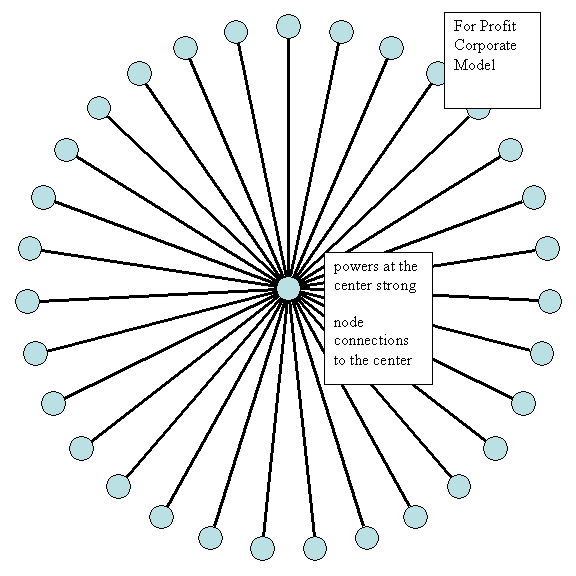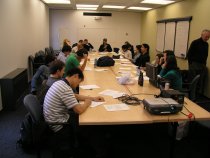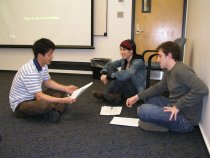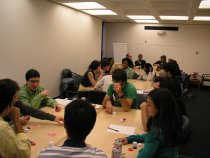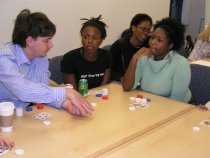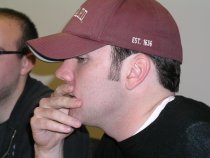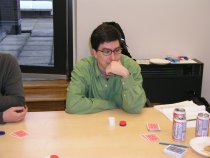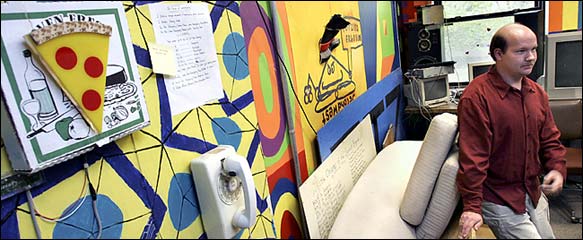I. Legal Backdrop of p2p File-Sharing
The American copyright law statutory monopoly itself balances rights-holders’ and others’ interests. It recognizes no absolute right of a creator to control her work. Rather, accepting that sufficient financial incentive to stimulate creation is needed, it grants creators the alienable, exclusive rights of reproduction, distribution, preparation of derivative works, and public performance and display. The law constrains the monopoly by recognizing a range of uses from which society benefits for not having to pay. For example, the fair use defense exempts from copyright infringement uses such as criticism, comment, news reporting, teaching, scholarship, and research.
[-benefits like being vulnerable to lawsuit for using in your creative work the creativity of creators who have come before. In this field creatorswithoutlawyers are allowed to stand on the shoulders of giants only if copyright has expired. Thus is creativity humbled to the lord of commerce.]
Secondary liability is a common law doctrine, existing in two forms. It holds facilitating or supervising parties responsible for others’ direct infringements. It has never been explicitly codified by Congress.
[This is Grokster’s strong point, this law to appease established interests when dynamic new technology comes along should give way to Sony’s principle.]
Contributory infringement requires (1) knowledge of another’s infringing conduct and (2) causation, inducement, or material involvement. Vicarious infringement exists where one has (1) the right and ability to supervise the infringing conduct and (2) a direct financial interest.
[Now I’m getting lost in the numbers. I’ve got primary and secondary liability, that’s 2, with secondary split in two forms, to me that’s 3 but you get four, like your second split left behind some third part of secondary liability undivided.]
These doctrines impose liability on providers of two types of products and services.
[now this is getting silly]
The first type is products and services only used to infringe. The other type is those which could be used for both infringing and non-infringing purposes (“dual-use”). Because actors should not profit purely from enabling others’ law-breaking, liability is easily imposed on the first, but the proper legal treatment of the second is more debatable.
[Please, something save us!]
In Sony v. Universal (“Sony”), the Supreme Court first considered the applicability of secondary liability to dual-use technologies. Copyright holders Universal and Disney sued Sony, alleging contributory copyright infringement because consumers were violating the plaintiffs’ exclusive right of reproduction using Sony’s videocassette recorders (VCRs) to copy plaintiffs’ copyrighted films. The Supreme Court did not hold Sony secondarily liable, analogizing to Congress’ patent law “staple article of commerce” doctrine. Patent law policy is clear: the patent monopoly is granted in the public interest, and the patentee may not leverage it to create a second monopoly over dual-use goods. The Supreme Court, similarly, balanced the copyright holder’s need for actual protection of its statutory monopoly with others’ rights to participate in substantially unrelated areas of commerce.
[This last strikes me — others’ rights to participate in substantially unrelated areas of commerce. Would it be significant under this wing of Sony thought that Grokster is eating the Record Industry’s lunch! You raise an excellent question.]
The resulting test for contributory infringement held that a company was not secondarily liable for infringing uses of its product if “the product is widely used for legitimate, non-objectionable purposes. Indeed, it need merely be capable of substantial, non-infringing use.” Using this standard, Sony was innocent of contributory liability, since the VCR was capable of non-infringing uses such as time-shifting. The Supreme Court majority found it irrelevant that the VCR’s primary use was the unauthorized copying of copyrighted works. The Sony standard for secondary liability only became problematic as applied fifteen years later, following the genesis of p2p networks.
[So Sony’s primary use was for copyright infringement in a manner that treaded very lightly on the commercial as opposed to theoretical interest of the copyright holders, which the Supreme Court expressed by calling no underlying infringement, fair use to time shift, beachhead for the consumer, and if the alleged direct infringer walks on the charge, then the threat of secondary liability against the corporation that made it possible goes out the window. Nice. So now the task is to see how the principle of Sony cuts Grokster.]
A p2p file-sharing network facilitates direct file transfers between end-users, as opposed to a client-server transfer, in which the end-user downloads files from a central server.
[How is a p2p end-user different from a VCR time-shifter?]
The networks typically require three elements: a computer program connecting end-users to the network, a search mechanism to locate desired files, and a process by which requested file-transfers occur.
[Well stated, simple, profound, music just one small part of what can be passed around.]
Within the music file-sharing context, p2p was a response to the court-ordered closure of directly infringing client-server music distribution sites such as mp3.com. Such sites illegally made available large numbers of copyrighted files, which rendered them both readily targeted for lawsuit and easily shut down.
[Meaning that lower courts called them foul. But were they? We embody our Law Lord in our Supreme Court.]
Napster was the first large-scale, p2p response to these shutdowns; it consisted of both a product and a service. It left the files on end-users’ computers rather than hosting them on a central server. The product, software enabling connection to the file-sharing network, was available for download via napster.com. Users running the software could connect to the Napster server to search for mp3 files available on the network. Once they found the desired files, they downloaded it directly from another user. Thus, Napster also provided a necessary, on-going service – the search function – via a central server over which it retained control.
[What is the principle on which the Napster court called foul? That a new business enterprise must do all in its power to protect copyright holders from infringement by users of the new enterprise’s … and here we split between product and service?]
This centralized service that was the focus of the recording industry suit against Napster for contribuory and vicarious infringement. The Ninth Circuit affirmed the lower court’s finding of liability on both counts. To evaluate contributory infringement, the court first looked to the element of material contribution. The court found the element satisfied by Napster’s provision of a centralized search server and its wherewithal to block infringing users or files from the network. The court then looked to Napster’s knowledge of infringement, subsuming Sony’s standard that technologies need merely be capable of substantial, non-infringing use into its knowledge test. The court held that the standard would absolve product or service providers of secondary infringement liability who had only constructive knowledge of direct infringement. However, those who had actual knowledge of infringements, such as Napster, could not claim the standard as a defense. Napster was also found liable for vicarious infringement because its central server gave it the right and ability to restrict distribution of infringing files on its network. Notably, the Ninth Circuit blurred the distinction between products and services in this case. The preliminary injunction that it affirmed was a recording industry victory that sounded Napster’s death-knell. However, it only marked the beginning of the scramble to succeed Napster.
[Did the Napster court consider at all the benefits that flow from serving content from a central server, or a ring of mirrored servers? Did the Napster court see Napster as a library?]
Soon on Napster’s heels came the Seventh Circuit’s Aimster case. Aimster distributed software that allowed users to connect to America Online’s Instant Messaging (AIM) network. The software expanded on the network’s ability to allow users to share files with their AIM “buddies”: it allowed members to designate the entire Aimster network as buddies. This allowed each user to search the shared files of all others. p2p transfers made use of AIM’s connectivity and Aimster’s encryption. Aimster generated its profit via a paid service called “Club Aimster”, which offered subscribers instant access to p2p downloads of popular songs for five dollars a month. The music industry’s suit for contributory and vicarious infringement was inevitable.
This case reached the Seventh Circuit, which affirmed as to contributory infringement, pointing to three factors. First, Aimster materially contributed to infringement through Club Aimster, which featured the forty most downloaded songs, all under copyright. Second, Aimster’s new-user tutorial made reference solely to copyrighted works. Aimster was liable for contributory infringement because it failed to provide evidence of non-infringing uses for its system of any magnitude. Third, the court dropped a bombshell: a dual-use technology’s capacity for substantial non-infringing use would be insufficient to avoid secondary liability. Rather, the dual-use system would need actual substantial, non-infringing uses, demonstrated by estimates of the respective magnitudes of non-infringing and infringing use. The court went yet further: to avoid contributory liability for dual-use products, developers would have to show that reducing or eliminating infringing uses would have entailed disproportionate cost. Aimster satisfied the knowledge prong of contributory infringement by virtue of its encryption technology, which the court saw as a purposive attempt at self-blindness. Finally, the court considered vicarious infringement an academic issue, for which it posed an unresolved question – whether, if infringement could be thwarted by change of system design, failure to do so could render defendants vicariously liable. It then ended Aimster’s brief existence by affirming the lower court’s preliminary injunction.
[Posner, observes that the sony principle as often stated lacks balance. He finds it in predatory practice. How does this line up with the interesting strand of Sony you identified?
The next generation of p2p file-sharing programs learned well the legal lessons that Napster and Aimster taught. Their redesign had major consequences in the next showdown.
[Now the lawyers are in charge. Engineering must now make it past the general counsel’s office. Like prodding dogs with sticks to make them vicious, making them take on the character of those who are prodding them. Napster, which was loved and killed, breeds Grokster.]
###

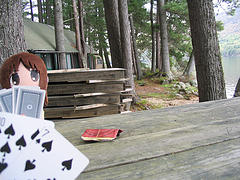

 This morning when I went to show Roberto the entry on my blog with our audio interview, to my complete bafflement the blog entry for Mangabeira is gone! Some genie in the bottle, computer gods once again at work. In any event here again,
This morning when I went to show Roberto the entry on my blog with our audio interview, to my complete bafflement the blog entry for Mangabeira is gone! Some genie in the bottle, computer gods once again at work. In any event here again, 
